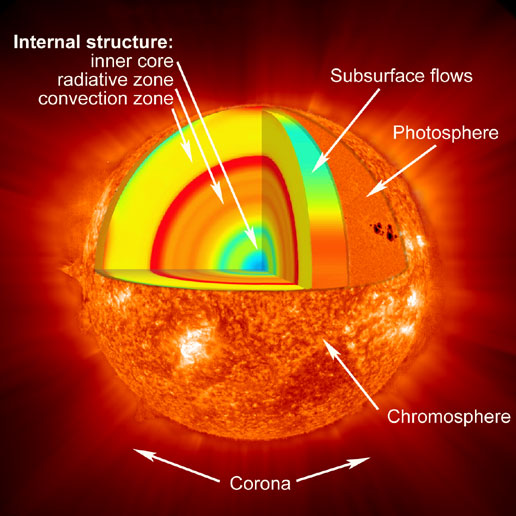 the Sun just looks like a fiery ball of plasma in space, it’s actually broken up into different parts. Let’s take a look at each of the parts of the Sun, starting from the middle.
the Sun just looks like a fiery ball of plasma in space, it’s actually broken up into different parts. Let’s take a look at each of the parts of the Sun, starting from the middle.Deep within the Sun is the core; a part of the Sun where the temperatures and pressures are so great that nuclear fusion reactions can take place. The core of the Sun accounts for about 0.2 solar radii, and it’s the hottest part of the Solar System with a temperature of close to 15 million kelvins. Energy pours out of the solar core because of thermonuclear reactions that convert hydrogen into helium. In fact, 3.6 x 1038 protons are converted into helium nuclei every second. This releases 3.8 x 1026 watts of energy every second.
Radiative Zone
Surrounding the core is the Sun’s radiative zone. This part of the Sun is hot and dense enough that energy from the core can radiate outward. Ions of hydrogen and helium emit photons. These photons travel a short distance and then are absorbed by another ion nearby. Photons make a slow journey up through the radiative zone in this way, Astronomers believe that a single photon might take 100,000 years to journey through the radiative zone.
Convective Zone
In this outer part of the Sun, the solar plasma isn’t hot and dense enough to transfer energy through radiation. Instead it uses a process called convection, similar to a lava lamp, where thermal columns carry heat from the edge of the radiative zone up through the convective zone to the surface of the Sun. The plasma in the thermal columns release their heat and then sink back down through the convective zone to heat up again.
Photosphere
The part of the Sun that we can see is called the photosphere. This is the point where photons generated at the core of the Sun can finally reach space. Below the photosphere and the Sun is opaque to visible light. And above the photosphere, becomes the Sun’s atmosphere. This is also the region where we see sunspots, and where solar flares and coronal mass ejections are generated.
We have written many articles about the Sun for Universe Today. Here’s an article about how the Sun alters the Earth’s climate, and here’s an article about the Sun’s future.
You can learn more about the Sun from NASA. Here’s NASA’s World Book on the Sun, and here’s more information from the Jet Propulsion Laboratory.
We have also recorded an entire episode of Astronomy Cast about the Sun. Listen to it here, Episode 30: The Sun, Spots and All.
References:
NASA: The Solar Interior
NASA StarChild: The Sun

No comments:
Post a Comment